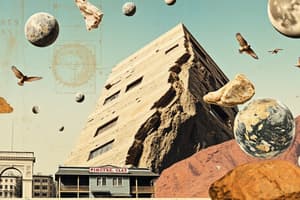Podcast
Questions and Answers
What characterizes minerals that exist in elemental form?
What characterizes minerals that exist in elemental form?
- They are typically unstable.
- They are inactive and unresponsive. (correct)
- They are highly reactive.
- They usually form compounds.
Which of the following is a non-metallic mineral element?
Which of the following is a non-metallic mineral element?
- Sulfur (correct)
- Gold
- Platinum
- Mercury
What determines the hardness of minerals?
What determines the hardness of minerals?
- The mineral's abundance in nature.
- Their color and appearance.
- The temperature at which they were formed.
- The chemical composition and testing method. (correct)
At what point on the Mohs scale does calcite rank?
At what point on the Mohs scale does calcite rank?
Which mineral is likely to decompose when heated and produce metal oxides?
Which mineral is likely to decompose when heated and produce metal oxides?
Which of the following minerals is used to exist in glass manufacturing due to its high melting point?
Which of the following minerals is used to exist in glass manufacturing due to its high melting point?
What gas is released when metal carbonates decompose upon heating?
What gas is released when metal carbonates decompose upon heating?
What effect does sulfur dioxide gas have when introduced to an acidic potassium permanganate solution?
What effect does sulfur dioxide gas have when introduced to an acidic potassium permanganate solution?
What is one use of calcium oxide?
What is one use of calcium oxide?
Which statement regarding metal oxides is correct?
Which statement regarding metal oxides is correct?
Flashcards are hidden until you start studying
Study Notes
Minerals
- Minerals are naturally occurring substances with a fixed chemical composition, typically found in rocks.
- Minerals can exist as elements or compounds.
- Elemental minerals are usually inactive and unresponsive.
- Examples of elemental minerals include metallic elements (gold, silver, mercury, platinum) and non-metallic elements (carbon, sulfur).
- Elements that combine with oxygen or sulfur form compounds and become more stable.
Physical Properties
- Minerals display a variety of colors and hardness levels based on their chemical composition.
- Mineral hardness can be determined by scratching or using a sclerometer.
- Harder minerals scratch softer minerals.
- The Mohs hardness scale measures mineral hardness, with diamond being the hardest (scale 10) and calcite being relatively soft (scale 3).
Chemical Properties
- Most minerals are insoluble in water, except those containing sodium and potassium.
- Minerals containing metal oxides or carbonates react with acids, dissolving and releasing carbon dioxide gas.
- Metal oxide minerals are more stable and don't decompose easily when heated, but they produce pure metals and carbon dioxide gas when heated with carbon.
- Metal carbonate minerals decompose when heated, producing metal oxides and carbon dioxide gas, except for sodium and potassium carbonates.
- The released carbon dioxide gas will cloud lime water.
- Metal sulfides decompose when heated in air, producing metal oxides and sulfur dioxide gas.
- Sulfur dioxide gas has a strong odor and turns purple in an acidic solution of potassium permanganate.
Uses of Minerals
- Calcium oxide and calcium carbonate (limestone) are used to neutralize acidic soils.
- Calcium carbonate is also used in blast furnaces to remove impurities during iron extraction.
- Silicon dioxide (silica) found in sand has a high melting point (1713°C) and is used to make glass.
- Aluminum oxide is commonly found in sunscreens and cosmetics like nail polish and lipstick.
Studying That Suits You
Use AI to generate personalized quizzes and flashcards to suit your learning preferences.




